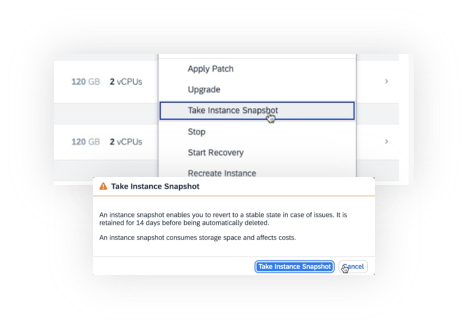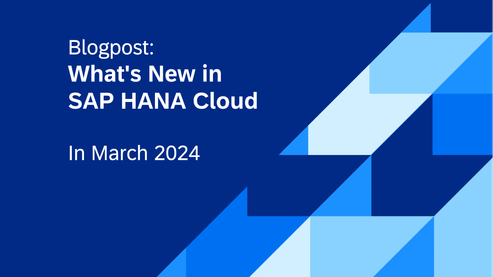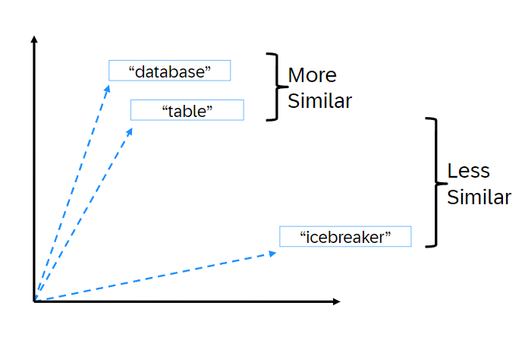
- SAP Community
- Products and Technology
- Technology
- Technology Blogs by SAP
- What’s New in SAP HANA Cloud – March 2024
- Subscribe to RSS Feed
- Mark as New
- Mark as Read
- Bookmark
- Subscribe
- Printer Friendly Page
- Report Inappropriate Content
The first quarter of the year is already over, which means we are happy to announce that the first release of SAP HANA Cloud in 2024 is live now!
Before diving deeper into the innovations included, let me share one thing: In case you want to hear about the innovations from our product experts first-hand, make sure to watch our What’s New in SAP HANA Cloud webcast, soon to be uploaded on our YouTube channel, or take a look at my top features for this releases in less than 5 minutes.
Contents
Innovations in SAP HANA Cloud, SAP HANA Database
Administration and Service Management
Migration support for SAP HANA extended application services (XSA)
Innovations in SAP HANA Cloud, data lake
Concise auditing for the relational engine
Further Innovations and Enhancements
Innovations in SAP HANA Cloud, SAP HANA Database
Now let’s kick it off with some exciting enhancements for our SAP HANA database within SAP HANA Cloud.
SAP HANA Cloud Multi-Model
One of the specific benefits of SAP HANA Cloud are its multi-model capabilities. With the first release of the year, there are two significant innovations to note in this area.
General Availability of the Vector Engine for SAP HANA Cloud
Let’s start with the introduction of the Vector Engine. With this new engine, you can seamlessly store and query vector embeddings alongside your business data. SAP HANA Cloud database will now support an in-built vector data type 'REAL_VECTOR' and two new functions, L2Distance() and cosine_similarity() that will enable similarity and semantic search metrics on the embeddings stored in SAP HANA Cloud.
The main function of the vector engine is to identify the closest data points (k nearest neighbors) to a specific query. This is achieved using the "similarity search" metrics. The engine allows you to perform all essential tasks (create, read, update, and delete) on vector data using familiar SQL commands.
The vector engine offers two methods to compare your query data (query embedding) to existing data (column vectors):
- L2 Distance: This method calculates the straight-line distance between the data points in the vector space. Lower distances indicate closer points and thus, higher similarity.
Syntax: L2DISTANCE(<vector1>, <vector2>)
- Cosine Similarity: This method compares the angles between the data points. Here, a higher value signifies greater similarity, indicating the points are pointing in similar directions within the space.
Syntax: COSINE_SIMILARITY(<vector1>, <vector2>)
In the dynamic world of AI and Generative AI-driven businesses, the SAP HANA Vector Engine will serve as an essential foundation for empowering Large Language Models. It not only enhances their decision-making process but also facilitates more contextually accurate responses to critical business queries and allows customers to infuse their valuable and sensitive data into AI scenarios. Also, SAP HANA Cloud Vector Engine will be one of the strongest pillars in the SAP's GenAI Strategy.
Key benefits of the SAP HANA Cloud Vector Engine include:
- Unified Data Management: Store and manage all your data, including vectors, within a single secure platform.
- Simplified Data Interaction: Leverage familiar SQL commands to work with all data types, including vectors.
- Deeper Data Exploration: Combine various data formats (spatial, graph, JSON, etc.) with vector-based queries for richer insights.
- Flexible Development: Integrate vector use cases into your solutions using diverse tools like SAP HANA Cloud clients (Python), hana-ml, and SAP CAP.
If you want to learn more about the benefits our SAP HANA Cloud Vector Engine offers, and how it can be integrated into your intelligent data applications and generative AI scenarios, don’t miss out on reading more about the Vector Engine and registering for our webinar on April 4.
Spatial function expansions
Next and also in the area of multi-model data processing, we are expanding our spatial functions to now cluster not just points, but also polygons and other shapes.
This enhancement allows for deeper insights into your data, uncovering hidden patterns and connections that were previously overlooked. Furthermore, the inclusion of ST_Centroid() support on a round-earth system ensures that calculations are more precise than ever before, providing users with reliable results. This upgrade addresses previous gaps in our spatial features, seamlessly meeting user needs and enhancing the power and reliability of spatial analysis.
To facilitate this SAP HANA Cloud spatial will now support an intersection-based clustering algorithm. The intersection-based clustering identifies "connected components" within geometries. In this context, a "connected component" represents the largest connected subset of geometries. Geometries that do not intersect with any other geometry will be categorised as outliers.
Administration and Service Management
Administering your database is essential which is why we are again significantly improving the experience with the current release of SAP HANA Cloud.
Management and monitoring using subaccount-level APIs
I am excited to announce a transformative update that enhances operational efficiency and monitoring capabilities. Now, administrators can automate tasks and monitor database metrics across all SAP HANA databases within a subaccount. This release of the new subaccount-level APIs introduces support for mapping database instances to Cloud Foundry spaces or Kyma namespaces.
These features not only automate administrative operations but also provide access to vital monitoring statistics through programmatic interfaces, streamlining management and ensuring optimal database performance.
You can find more details on the APIs via the SAP Business Accelerator Hub.
Terraform support for managing SAP HANA Cloud databases
We're thrilled to also unveil another feature for SAP HANA Cloud that greatly benefits administrators managing diverse cloud services on Kubernetes clusters. With this update, SAP HANA Cloud now supports automation of database provisioning, configuration, and lifecycle management through Terraform.
This integration allows the use of Terraform within the SAP Business Technology Platform (SAP BTP), enhancing our suite of services with basic, yet powerful, functionality. It not only elevates customer satisfaction by aligning with tools you already utilize but also empowers Terraform users with a consistent, state-based method for managing SAP HANA Cloud configurations efficiently.
Cloud Reliability
You, our customers, are running business-critical processes on top of SAP HANA Cloud. Therefore, we are eager to further strengthen the reliability of SAP HANA Cloud with each release and are happy to once again introduce a handful of innovations in this regard.
Snapshot recovery for instances with high availability (HA) setup
SAP HANA Cloud, SAP HANA database now supports volume snapshot recovery for instances in high availability (HA) setups. This enhancement allows for utilization of snapshot creation and recovery across both replication setups: high availability (HA) and disaster recovery (DR) systems. Furthermore, it enabled swift data recovery using volume snapshots of the primary node in a replication setup.
Enhance your data resilience and recovery strategy effortlessly with our newest update.
User interface for volume snapshots
On top, we are delighted to announce a new user interface (UI) for managing instance snapshots.
This new feature significantly improves the ease of use by providing a UI option for snapshot management, in addition to the existing command line interface and allows for more flexibility in handling SAP HANA Cloud instance snapshots.

Migration support for SAP HANA extended application services (XSA)
Moreover, we are excited to introduce an update that facilitates the migration of service instances managed through the advanced model of SAP HANA extended application services (XSA) to Cloud Foundry. This update encompasses the migration HDI containers, plain schemas, and secure-store service, along with migrating service instances managed through the instance manager to the service manager of Cloud Foundry.
This enhancement greatly extends the capabilities for migrating on-premise SAP HANA databases to SAP HANA Cloud, empowering users with the seamless transition of extended application services (XSA) service instances.
Data Integration
Data integration is crucial, and I am therefore delighted to announce the following innovations further enhancing SAP HANA Cloud’s respective capabilities.
Virtualization of ABAP CDS views when an ABAP system is the remote source
First, we are introducing a powerful capability that allows for the creation of remote sources to an ABAP system, utilizing the latest advancements in the ABAP programming language (release 2108 or later), through SAP HANA smart data access (SDA). This feature enables the virtualization of ABAP CDS view entities using the SAP HANA database component of SAP HANA Cloud. For enhanced security and connectivity, a cloud connector can be used when linking to an on-premise ABAP system protected by a firewall, like SAP S/4HANA. Additionally, this update supports passing parameters to remote parameterized ABAP CDS view entities.
This significant enhancement addresses and lifts the limitations previously described in SAP Note 2511210 - Access to ABAP-Managed Database Objects, by facilitating access to the ABAP SQL service endpoint rather than directly interacting with the underlying SAP HANA of the ABAP system. For more detailed information on supported remote sources, please refer to SAP Note 2600176 - SAP HANA Smart Data Access Supported Remote Sources.
For a more detailed explanation and more insights into this innovation, make sure to read Seungjoon Lee’s blogpost, Taking Data Federation to the Next Level: Accessing Remote ABAP CDS View Entities in SAP HANA Cloud.
Improved data import from and export to cloud object stores
Next, I am thrilled to introduce an update to SAP HANA Cloud that expands its data interoperability and flexibility. With our latest enhancement, users can now seamlessly import nested Parquet files directly from cloud object stores.
This feature opens a world of possibilities, allowing for enhanced data exchange and collaboration with external systems that leverage nested Parquet files. By embracing this advanced file format, SAP HANA Cloud further solidifies its commitment to empowering users with comprehensive data management solutions that adapt to diverse data ecosystems. Unlock the full potential of your data and streamline the way you interact with and integrate data across platforms.
On the export side, I am also excited to shed some light on a new feature that allows you to directly export data to cloud object stores based on SELECT statements, eliminating the need to first create tables or views. Additionally, this feature allows exporting data as multiple Parquet or CSV files, with the option to specify the number of files to be exported.
This enhancement not only streamlines the data export process, enabling on-demand data export with ease and flexibility but also improves performance and optimizes memory management when handling large amounts of data and catalogs. Furthermore, it provides better control over the data export process by allowing you to define the number of files to be exported, enhancing the efficiency and manageability of your data export tasks.
Row-level access control for views and hierarchy functions
Another important enhancement to SAP HANA Cloud allows for fine-grained control over user access. Now, users can precisely manage access to SQL views, parameterized views, and calculation views, all while utilizing structured filters for access control management. This update represents a major leap forward in usability and security, offering users a high degree of control over their data at the SAP HANA database level.

Innovations in SAP HANA Cloud, data lake
Moving on to the second major component of SAP HANA Cloud, the data lake, I am once again thrilled to introduce innovations in this area.
Multi-zone availability
Extremely relevant and now live is the support for multi-zone availability within a cloud provider region for the SAP HANA Cloud, data lake. Strengthen your business continuity with better service availability, thanks to multi-zone replication and service setup.
Concise auditing for the relational engine
I am thrilled to announce a significant enhancement to the auditing capabilities for SAP HANA Cloud, data lake relational engine. With the addition of audit events to the collected data, auditing becomes even more robust and comprehensive when enabled.
In parallel, we have optimized the auditing process by discontinuing the collection of specific legacy events that generated excessive audit data without being utilized by customers. This refinement not only ensures higher quality auditing but also streamlines the audit output by reducing unnecessary information. Experience enhanced auditing precision and efficiency with SAP HANA Cloud's latest update.
Further Innovations and Enhancements
Like every release, the QRC1 2024 also contains some general news and enhancements. This time I am happy to shed some more light especially into the area of database tooling, database application development and graphical view modeling.
Database Tooling
SQL Console in SAP HANA Cloud Central
The SQL Console in SAP HANA Cloud Central now has a settings tab in SAP HANA Cloud Central that is used to persist its settings. In addition, the Result Format Settings have been added which enable the results tab to be formatted.
An example of a formatted result can be seen below.
Database Application Development
Application-controlled locks for concurrent application servers
We are happy to introduce a powerful enhancement that significantly boosts the performance and scalability of concurrent application servers. With the addition of application-controlled locks, your applications gain finer control over concurrent operations, leading to enhanced performance and scalability. By leveraging this capability, your system can better manage resource contention and optimize throughput, resulting in smoother and more efficient operation of your application servers.
For more details, please refer to SAP Note #3432435 - Built-In Procedures for Managing Application Locks.
CALL ACQUIRE_APPLICATION_LOCK('<user-defined_lock_name>', '<lock_mode>', '<lock_scope>', '<lock_timeout>’)
CALL RELEASE_APPLICATION_LOCK('<user-defined_lock_name>', '<lock_scope>’)
<lock_mode> := EXCLUSIVE, SHARED
<lock_scope> := TRANSACTION, SESSION
Database role assignment from SAP Business Application Studio
Additionally, I am excited to introduce an enhancement to SAP HANA Cloud that streamlines role management within SAP Business Application Studio (BAS). Now, users can seamlessly grant HDI roles directly from their development projects, all within a graphical interface. With the provision of a text field for entering target principal names and a list of roles, role assignment becomes more intuitive.
Leveraging the HDI container API, developers can efficiently manage role assignments, reducing development time and improving total cost of ownership. This UI-based option not only accelerates development processes but also fosters intuitive adoption among developers, empowering them to focus on innovation and driving business success.
Graphical View Modeling
Once again, we have also provided numerous enhancement and new functionalities to our solution in regard to its graphical view modeling capabilities. While highlighting some below, you can also find a comprehensive blog post by Jan Zwickel, which is going into all details.
Looking for more details on the latest features and updates to SAP HANA Cloud? Take a look at our What’s New Viewer in our Technical Documentation, which describes the entire scope of the release.
Finally, it’s important to say: Don’t forget to follow the SAP HANA Cloud tag to not miss any updates on SAP HANA Cloud! In addition, the whatsnewinsaphanacloud tag collects all what’s new blog posts, so you won’t have a hard time finding all the necessary information. In the unfortunate case that you have missed the What’s New webinar in Q4 2023, you can find it and all future webinars in this playlist on YouTube. We hope you are curious for our upcoming webcast on the new innovations, being available in the same playlist on YouTube soon.
Do you want to discuss some of the outlined innovations or have any other questions related to SAP HANA Cloud? Feel free to post them in our SAP HANA Cloud Community Q&A or in the comments below.
You must be a registered user to add a comment. If you've already registered, sign in. Otherwise, register and sign in.
-
ABAP CDS Views - CDC (Change Data Capture)
2 -
AI
1 -
Analyze Workload Data
1 -
BTP
1 -
Business and IT Integration
2 -
Business application stu
1 -
Business Technology Platform
1 -
Business Trends
1,658 -
Business Trends
93 -
CAP
1 -
cf
1 -
Cloud Foundry
1 -
Confluent
1 -
Customer COE Basics and Fundamentals
1 -
Customer COE Latest and Greatest
3 -
Customer Data Browser app
1 -
Data Analysis Tool
1 -
data migration
1 -
data transfer
1 -
Datasphere
2 -
Event Information
1,400 -
Event Information
67 -
Expert
1 -
Expert Insights
177 -
Expert Insights
301 -
General
1 -
Google cloud
1 -
Google Next'24
1 -
GraphQL
1 -
Kafka
1 -
Life at SAP
780 -
Life at SAP
13 -
Migrate your Data App
1 -
MTA
1 -
Network Performance Analysis
1 -
NodeJS
1 -
PDF
1 -
POC
1 -
Product Updates
4,577 -
Product Updates
346 -
Replication Flow
1 -
REST API
1 -
RisewithSAP
1 -
SAP BTP
1 -
SAP BTP Cloud Foundry
1 -
SAP Cloud ALM
1 -
SAP Cloud Application Programming Model
1 -
SAP Datasphere
2 -
SAP S4HANA Cloud
1 -
SAP S4HANA Migration Cockpit
1 -
Technology Updates
6,873 -
Technology Updates
429 -
Workload Fluctuations
1
- SAP Fiori for SAP S/4HANA - Empowering Your Homepage: Enabling My Home for SAP S/4HANA 2023 FPS01 in Technology Blogs by SAP
- SAP Partners unleash Business AI potential at global Hack2Build in Technology Blogs by SAP
- It’s Official - SAP BTP is Again a Leader in G2’s Reports in Technology Blogs by SAP
- What’s New in SAP Analytics Cloud Release 2024.08 in Technology Blogs by SAP
- Deep dive into Q4 2023, What’s New in SAP Cloud ALM for Implementation Blog Series in Technology Blogs by SAP
| User | Count |
|---|---|
| 33 | |
| 17 | |
| 15 | |
| 13 | |
| 11 | |
| 9 | |
| 8 | |
| 8 | |
| 8 | |
| 7 |







